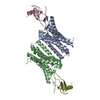+Search query
-Structure paper
| Title | Molecular mechanism of distinct chemokine engagement and functional divergence of the human Duffy antigen receptor. |
|---|---|
| Journal, issue, pages | Cell, Vol. 187, Issue 17, Page 4751-4769.e25, Year 2024 |
| Publish date | Aug 22, 2024 |
 Authors Authors | Shirsha Saha / Basavraj Khanppnavar / Jagannath Maharana / Heeryung Kim / Carlo Marion C Carino / Carole Daly / Shane Houston / Saloni Sharma / Nashrah Zaidi / Annu Dalal / Sudha Mishra / Manisankar Ganguly / Divyanshu Tiwari / Poonam Kumari / Gagan Deep Jhingan / Prem N Yadav / Bianca Plouffe / Asuka Inoue / Ka Young Chung / Ramanuj Banerjee / Volodymyr M Korkhov / Arun K Shukla /      |
| PubMed Abstract | The Duffy antigen receptor is a seven-transmembrane (7TM) protein expressed primarily at the surface of red blood cells and displays strikingly promiscuous binding to multiple inflammatory and ...The Duffy antigen receptor is a seven-transmembrane (7TM) protein expressed primarily at the surface of red blood cells and displays strikingly promiscuous binding to multiple inflammatory and homeostatic chemokines. It serves as the basis of the Duffy blood group system in humans and also acts as the primary attachment site for malarial parasite Plasmodium vivax and pore-forming toxins secreted by Staphylococcus aureus. Here, we comprehensively profile transducer coupling of this receptor, discover potential non-canonical signaling pathways, and determine the cryoelectron microscopy (cryo-EM) structure in complex with the chemokine CCL7. The structure reveals a distinct binding mode of chemokines, as reflected by relatively superficial binding and a partially formed orthosteric binding pocket. We also observe a dramatic shortening of TM5 and 6 on the intracellular side, which precludes the formation of the docking site for canonical signal transducers, thereby providing a possible explanation for the distinct pharmacological and functional phenotype of this receptor. |
 External links External links |  Cell / Cell /  PubMed:39089252 / PubMed:39089252 /  PubMed Central PubMed Central |
| Methods | EM (single particle) |
| Resolution | 3.65 - 4.23 Å |
| Structure data | EMDB-36488, PDB-8jps:  EMDB-37212: Structure of Duffy Antigen Receptor for Chemokines (DARC)/ACKR1 in complex with the chemokine, CCL7 (Receptor original map)  EMDB-37214: Structure of Duffy Antigen Receptor for Chemokines (DARC)/ACKR1 in complex with the chemokine, CCL7 (Ligand/CCL7 focused map) |
| Source |
|
 Keywords Keywords | IMMUNE SYSTEM / GPCR / SIGNALING PROTEIN |
 Movie
Movie Controller
Controller Structure viewers
Structure viewers About Yorodumi Papers
About Yorodumi Papers





 homo sapiens (human)
homo sapiens (human)